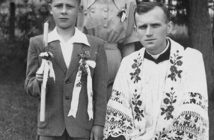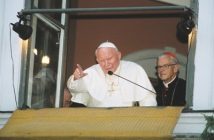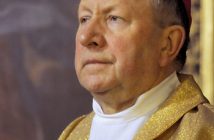In occasione di quasi tutte e le otto visite in Polonia Giovanni Paolo II veniva nella sua regione natale Małopolska. Celebrava le grandi messe nel famoso prato di Cracovia Błonia a cui partecipavano anche due milioni di persone, visitava altrettanto i monti Tatra per poter ammirare in pace dalla sommità di Kasprowy Wierch le sue amatissime montagne. Quando i tempi stretti del programma non permettevano di visitare la sua città natale Wadowice, chiedeva che l’aereo che lo portava facesse almeno un giro sopra il paese.
La prima visita di Giovanni Paolo II naturalmente portava a Cracovia. Capitava del resto nel novecentesimo anniversario della morte di San Stanislao vescovo di cracovia. Il papa passò lì sei giorni. Abitava a casa sua ovvero nella residenza dei vescovi di Cracovia. Così sarà in occasione di tutti i suoi soggiorni a Cracovia. Visitò anche Kalwaria Zebrzydowska, Wadowice, l’ex campo di concentramento tedesco Auschwitz-Birkenau, celebrò grandi messe per i montanari a Nowy Targ e a Błonia. Dall’aeroporto di Balice vicino Cracovia volò a Roma, lasciando tuttavia i polacchi con la speranza risvegliata dalle sue parole: “Scenda il Tuo Spirito! E rinnovi il volto della terra. Questa Terra! ”
La visita seguente si svolgeva già in un’atmosfera sociale e politica completamente diversa. Nel 1983 la Polonia era stretta dalle conseguenze della proclamazione nel 1981 della legge marziale. Il papa andò a trovare le città in cui l’opposizione contro il regime comunista era più forte. Nuovamente celebrò una messa a Błonia a Cracovia, in un rifugio nei Tatra incontrò Lech Wałęsa, il capo della “Solidarność” e ovviamente conversò a lungo con i giovani che lo aspettavano sotto la cosiddetta finestra papale.
Nel 1987 venne in patria un’altra volta. In Małopolska visitò Tarnów, dove beatificò Karolina Kózkówna, incontrò i cracoviensi a Błonia, visitò la cattedrale di Wawel, la tomba dei suoi genitori nel cimitero Rakowicki.
La quarta volta tornò ormai nella Polonia libera. Nel 1991 era accolto come un importante cofondatore della riconquistata sovranità e democrazia. Venne per partecipare alla VI edizione delle Giornate Mondiali della Gioventù a Częstochowa, tuttavia capitò a Cracovia e Wadowice.
Già nel 1995 ebbe avuto luogo un altro grande viaggio per la Polonia. A Cracovia partecipò alle celebrazioni di 600 anni dalla fondazione della facoltà di teologia all’Università Jagellonica e canonizzò la regina Edwige, rinnovatrice dell’università del 1400. Al grande trampolino sciistico a Zakopane incontrò un’altra volta gli abitanti della montagna.
Due anni dopo doveva celebrare una messa a Cracovia in occasione del primo millennio della diocesi cracoviense. Non venne però a Błonia a causa della malattia. Il giorno dopo invece celebrò la messa a Stary Sącz, e sulla piazza principale di Wadowice si incontrò con i suoi abitanti e ricordó in un modo indimenticabile la giovinezza passata lì.
L’ultima volta che Giovanni Paolo II venne in Polonia sempre più malato fu nel 2002. Qesta visita la dedicò interamente alla natale Małopolska. Consacrò il Santuario della Divina Misericordia a Cracovia Łagiewniki, così vicino al suo cuore. Ritornò a celebrare una messa a Błonia, visitò la cattedrale di Wawel e la tomba dei genitori, e in più anche il santuario della passione a Kalwaria Zebrzydowska, dove già da bambino veniva a piedi con il padre dalla vicina Wadowice. Si aveva un’impressione incontenibile che stesse salutando la Polonia. Diceva ormai: “Arrivederci. Se Dio vuole…”
La prima visita di Giovanni Paolo II naturalmente portava a Cracovia. Capitava del resto nel novecentesimo anniversario della morte di San Stanislao vescovo di cracovia. Il papa passò lì sei giorni. Abitava a casa sua ovvero nella residenza dei vescovi di Cracovia. Così sarà in occasione di tutti i suoi soggiorni a Cracovia. Visitò anche Kalwaria Zebrzydowska, Wadowice, l’ex campo di concentramento tedesco Auschwitz-Birkenau, celebrò grandi messe per i montanari a Nowy Targ e a Błonia. Dall’aeroporto di Balice vicino Cracovia volò a Roma, lasciando tuttavia i polacchi con la speranza risvegliata dalle sue parole: “Scenda il Tuo Spirito! E rinnovi il volto della terra. Questa Terra! ”
La visita seguente si svolgeva già in un’atmosfera sociale e politica completamente diversa. Nel 1983 la Polonia era stretta dalle conseguenze della proclamazione nel 1981 della legge marziale. Il papa andò a trovare le città in cui l’opposizione contro il regime comunista era più forte. Nuovamente celebrò una messa a Błonia a Cracovia, in un rifugio nei Tatra incontrò Lech Wałęsa, il capo della “Solidarność” e ovviamente conversò a lungo con i giovani che lo aspettavano sotto la cosiddetta finestra papale.
Nel 1987 venne in patria un’altra volta. In Małopolska visitò Tarnów, dove beatificò Karolina Kózkówna, incontrò i cracoviensi a Błonia, visitò la cattedrale di Wawel, la tomba dei suoi genitori nel cimitero Rakowicki.
La quarta volta tornò ormai nella Polonia libera. Nel 1991 era accolto come un importante cofondatore della riconquistata sovranità e democrazia. Venne per partecipare alla VI edizione delle Giornate Mondiali della Gioventù a Częstochowa, tuttavia capitò a Cracovia e Wadowice.
Già nel 1995 ebbe avuto luogo un altro grande viaggio per la Polonia. A Cracovia partecipò alle celebrazioni di 600 anni dalla fondazione della facoltà di teologia all’Università Jagellonica e canonizzò la regina Edwige, rinnovatrice dell’università del 1400. Al grande trampolino sciistico a Zakopane incontrò un’altra volta gli abitanti della montagna.
Due anni dopo doveva celebrare una messa a Cracovia in occasione del primo millennio della diocesi cracoviense. Non venne però a Błonia a causa della malattia. Il giorno dopo invece celebrò la messa a Stary Sącz, e sulla piazza principale di Wadowice si incontrò con i suoi abitanti e ricordó in un modo indimenticabile la giovinezza passata lì.
L’ultima volta che Giovanni Paolo II venne in Polonia sempre più malato fu nel 2002. Qesta visita la dedicò interamente alla natale Małopolska. Consacrò il Santuario della Divina Misericordia a Cracovia Łagiewniki, così vicino al suo cuore. Ritornò a celebrare una messa a Błonia, visitò la cattedrale di Wawel e la tomba dei genitori, e in più anche il santuario della passione a Kalwaria Zebrzydowska, dove già da bambino veniva a piedi con il padre dalla vicina Wadowice. Si aveva un’impressione incontenibile che stesse salutando la Polonia. Diceva ormai: “Arrivederci. Se Dio vuole…”

Pilgrimages to the Homeland
John Paul II took the opportunity to visit Małopolska on almost all of his eight pilgrimages to Poland. He also almost always celebrated Mass on Cracow’s Błonia (a large meadow close to the city centre), in which as many as 2 million people participated. He occasionally went to the Tatra Mountains, where he could quietly contemplate his beloved mountains from the top of Kasprowy Wierch. When there was not enough time in his programme to visit Wadowice, his birthplace, he would ask the pilot of the helicopter carrying him to at least make a circle over it.
Naturally, John Paul II’s first pilgrimage to Poland had to include Cracow, because the pilgrimage was made in 1979, the year in which the 900th anniversary of the martyrdom of St. Stanislaus, Bishop of Cracow, was celebrated. The Pope spent six days in the region, during which he stayed ‘at home’, i.e. at the residence of the Bishops of Cracow. Thus, a precedent was set and this was where he stayed on all his subsequent visits to the city. While in Cracow, he paid short visits to Kalwaria Zebrzydowska, Wadowice, and the former Nazi concentration camp, Auschwitz-Birkenau. He said Mass in front of vast crowds of highlanders in Nowy Targ and, naturally, on Cracow’s Błonia, again in front of huge numbers of people. It was from Balice near Cracow that he flew to Rome, leaving the Poles full of hope from the words he had spoken: ‘Let your Spirit descend and renew the face of the earth. The face of this land.’
The next pilgrimage to his homeland faced a completely different social and political situation. In 1983 Poland was overwhelmed by the consequences of Martial Law which had been introduced in 1981. The Pope visited those cities where resistance to the Communist regime was strongest. However, he once again celebrated Mass on Cracow’s Błonia, met Lech Wałęsa, the leader of the Solidarity movement, at a mountain hostel in the Tatras, and yet still managed to find time to talk to the young people, who always waited for him below the ‘Pope’s window’.
In 1987, he was in his homeland again. While in Małopolska he visited Tarnow, where he beatified Karolina Kózkówna, met Cracovians on Błonia, visited Wawel Cathedral and the grave of his parents in Rakowicki Cemetery.
He made his fourth pilgrimage in 1991 to an already free Poland and was greeted as someone who had made a considerable contribution to the process of Poland re-gaining her sovereignty and achieving democracy. Although the primary aim of his visit was to attend the 6th World Youth Festival in Częstochowa, he also visited Cracow and Wadowice.
His came to Poland for a relatively short time in 1995, as he visited only three Polish towns situated close to the border with the Czech Republic, which was the main focus of his visit. In 1997, he made another longer trip to Poland, during which he participated in the 600th anniversary celebrations of the establishment of the Faculty of Theology at the Jagiellonian University in Cracow and canonized Queen Jadwiga, who revived the University in 1400. In Zakopane he met again with highlanders at the foot of the large ski jump.
Two years later in Cracow he was to have celebrated Mass on the occasion of the millennium of the Cracow Diocese, but he could not be on Błonia that day due to illness. The next day, however, he said Mass in Stary Sącz and met with the residents of Wadowice in the town’s market square, movingly and unforgettably recalling his youth in the town.
An increasingly frail John Paul II came to Poland for the last time in 2002 and that visit was spent entirely in his native Małopolska. During it he consecrated the Sanctuary of Divine Mercy in Cracow, Łagiewniki, which was so close to his heart. Again, he celebrated Mass on Błonia, visited Wawel Cathedral, the grave of his parents and the Passion Sanctuary in Kalwaria Zebrzydowska, to which as a child he often went with his father from nearby Wadowice. Everyone had the overwhelming impression that he was saying goodbye to Poland. His last words in Poland were: „I will see you again. God willing…” (b)
Naturally, John Paul II’s first pilgrimage to Poland had to include Cracow, because the pilgrimage was made in 1979, the year in which the 900th anniversary of the martyrdom of St. Stanislaus, Bishop of Cracow, was celebrated. The Pope spent six days in the region, during which he stayed ‘at home’, i.e. at the residence of the Bishops of Cracow. Thus, a precedent was set and this was where he stayed on all his subsequent visits to the city. While in Cracow, he paid short visits to Kalwaria Zebrzydowska, Wadowice, and the former Nazi concentration camp, Auschwitz-Birkenau. He said Mass in front of vast crowds of highlanders in Nowy Targ and, naturally, on Cracow’s Błonia, again in front of huge numbers of people. It was from Balice near Cracow that he flew to Rome, leaving the Poles full of hope from the words he had spoken: ‘Let your Spirit descend and renew the face of the earth. The face of this land.’
The next pilgrimage to his homeland faced a completely different social and political situation. In 1983 Poland was overwhelmed by the consequences of Martial Law which had been introduced in 1981. The Pope visited those cities where resistance to the Communist regime was strongest. However, he once again celebrated Mass on Cracow’s Błonia, met Lech Wałęsa, the leader of the Solidarity movement, at a mountain hostel in the Tatras, and yet still managed to find time to talk to the young people, who always waited for him below the ‘Pope’s window’.
In 1987, he was in his homeland again. While in Małopolska he visited Tarnow, where he beatified Karolina Kózkówna, met Cracovians on Błonia, visited Wawel Cathedral and the grave of his parents in Rakowicki Cemetery.
He made his fourth pilgrimage in 1991 to an already free Poland and was greeted as someone who had made a considerable contribution to the process of Poland re-gaining her sovereignty and achieving democracy. Although the primary aim of his visit was to attend the 6th World Youth Festival in Częstochowa, he also visited Cracow and Wadowice.
His came to Poland for a relatively short time in 1995, as he visited only three Polish towns situated close to the border with the Czech Republic, which was the main focus of his visit. In 1997, he made another longer trip to Poland, during which he participated in the 600th anniversary celebrations of the establishment of the Faculty of Theology at the Jagiellonian University in Cracow and canonized Queen Jadwiga, who revived the University in 1400. In Zakopane he met again with highlanders at the foot of the large ski jump.
Two years later in Cracow he was to have celebrated Mass on the occasion of the millennium of the Cracow Diocese, but he could not be on Błonia that day due to illness. The next day, however, he said Mass in Stary Sącz and met with the residents of Wadowice in the town’s market square, movingly and unforgettably recalling his youth in the town.
An increasingly frail John Paul II came to Poland for the last time in 2002 and that visit was spent entirely in his native Małopolska. During it he consecrated the Sanctuary of Divine Mercy in Cracow, Łagiewniki, which was so close to his heart. Again, he celebrated Mass on Błonia, visited Wawel Cathedral, the grave of his parents and the Passion Sanctuary in Kalwaria Zebrzydowska, to which as a child he often went with his father from nearby Wadowice. Everyone had the overwhelming impression that he was saying goodbye to Poland. His last words in Poland were: „I will see you again. God willing…” (b)










